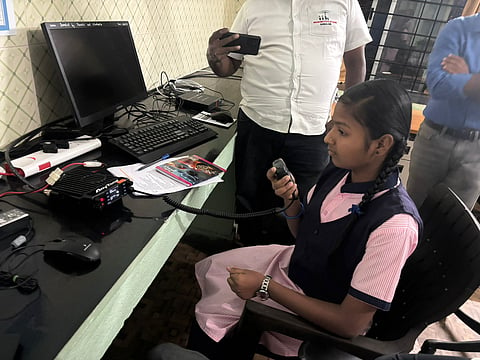

Mobile phones have made communication easier for everyone, especially if your friends and family are living in remote rural areas. But what if you aren't able to reach your family living in these remote areas in times of crisis like natural disasters?
That's when ham radios and Digital Radio Mondiale (DRM) stations installed at the Government Residential Schools and Colleges in Karnataka can come to your rescue.
Recently, the Indian Institute of Hams (IIH) in Bengaluru launched the Ham Yatra across Karnataka.
As a part of this initiative, Dr S Satyapal, Director of the Indian Institute of Hams, along with his team of ham operators, travelled across the state to install Digital Mobile Radio stations at residential schools.
Dr Satypal says, "We have covered approximately 5,500 kilometres by installing these DMR base stations at residential schools. The idea behind installing these stations was to help children communicate with institutions, researchers and scientists across the globe via ham. Most institutions and organisations can be connected through ham radio. Ham works on certain frequencies in radio signals."
Dr Satyapal stressed the point of creating curiosity among students about ample opportunities in Science.
"Both students and teachers can explore opportunities when they connect with ham operators around the globe. Being a Ham operators for more than three decades, it was my dream to interconnect institutions and conduct activities through ham radio in schools and colleges. IIH has promised free training to these school students interested in writing the Ham exam," he added.
Last year, IIH trained teachers and a few students from these residential schools regarding ham radio rules, regulations and operating procedures, communication networks during natural disasters, basic elections: semiconductors, filters, transceiver structures, radio wave (EM) propagation, aerials and transmission lines.
The institute also conducted exams for these teachers and students. Those who were able to qualify for the exam were provided with an Amateur License by the Wireless Planning and Coordination Wing of the Ministry of Communications and Information Technology.
So far, the IIH has installed DMR base stations in 20 government residential schools in Bengaluru rural, Hoskote, Kolar Sakleshpura, Hassan, Uttara Kannada, Belagavi, Gadag, Vijayapura, Chikkaballapur, Udupi districts.
Dr Satyapal explained his team's role in the installation of DMR stations at these schools.
"Our team consisting of five to eight ham operators have divided roles and responsibilities. Whenever these installations happen, we train the teachers and students at the spot. We demonstrate how DMR stations work, and try to connect with other hams to establish communication with them. We mention our call signs during this communication."
Dr Satypal believes that installation of DMR base stations at schools is a milestone in the ham radio movement. He says, "This DMR Network will not stop at the installations; IIH has plans to conduct interactive programmes, quizzes on air, contests, and so on, to keep the digital ham activity in the loop. We have also created a DMR group for internal communication with these 20 schools. This also connects to headquarters located in Bengaluru."
Not just Satyapal, even the teachers have found this initiative exciting. Shrishail Patil, Science teacher at Indira Gandhi Residential School, Sambrani Village in Uttara Kannada district represented his school and cleared the exam conducted by IIH last year. Their school was awarded with the license and a call sign BU3FZL.
Shrishail says, "Our school spent Rs 1,30,000 to buy the required equipment like transceiver, antenna and SWR meter. Now, we have a full-fledged DMR base station at school. Fewer children get to learn about ham radio and Morse code these days. From now on, our students can get free training to become a ham. They will be resourceful to the nation in times of crisis. Besides using it during events at schools, we are exploring opportunities to connect with researchers in the state and our country. We have got a long way to go."
For more on them, check out indianhams.com
